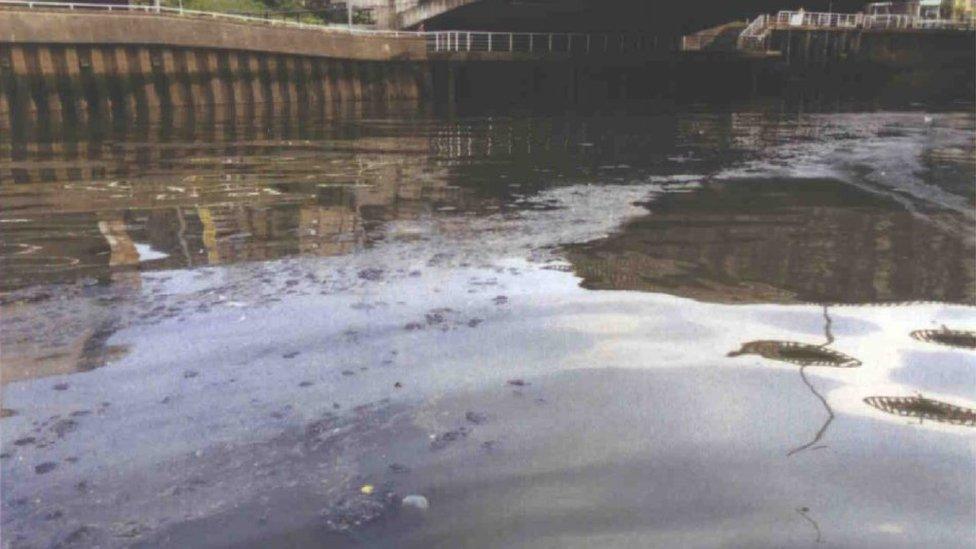Scotland's growing sewage spill problem
- Published
- comments

The number of recorded sewage spills in Scotland's rivers and seas has increased by 40% over the last five years, new figures show.
Scottish Water data shows the equivalent of 47,000 Olympic-sized swimming pools worth of waste has been discharged since 2016.
Campaigners are calling for more action to tackle the water waste issue.
But Scottish Water has warned the problem will not be solved by "building bigger and bigger sewers".
When there is heavy rain parts of the sewer network simply cannot cope.
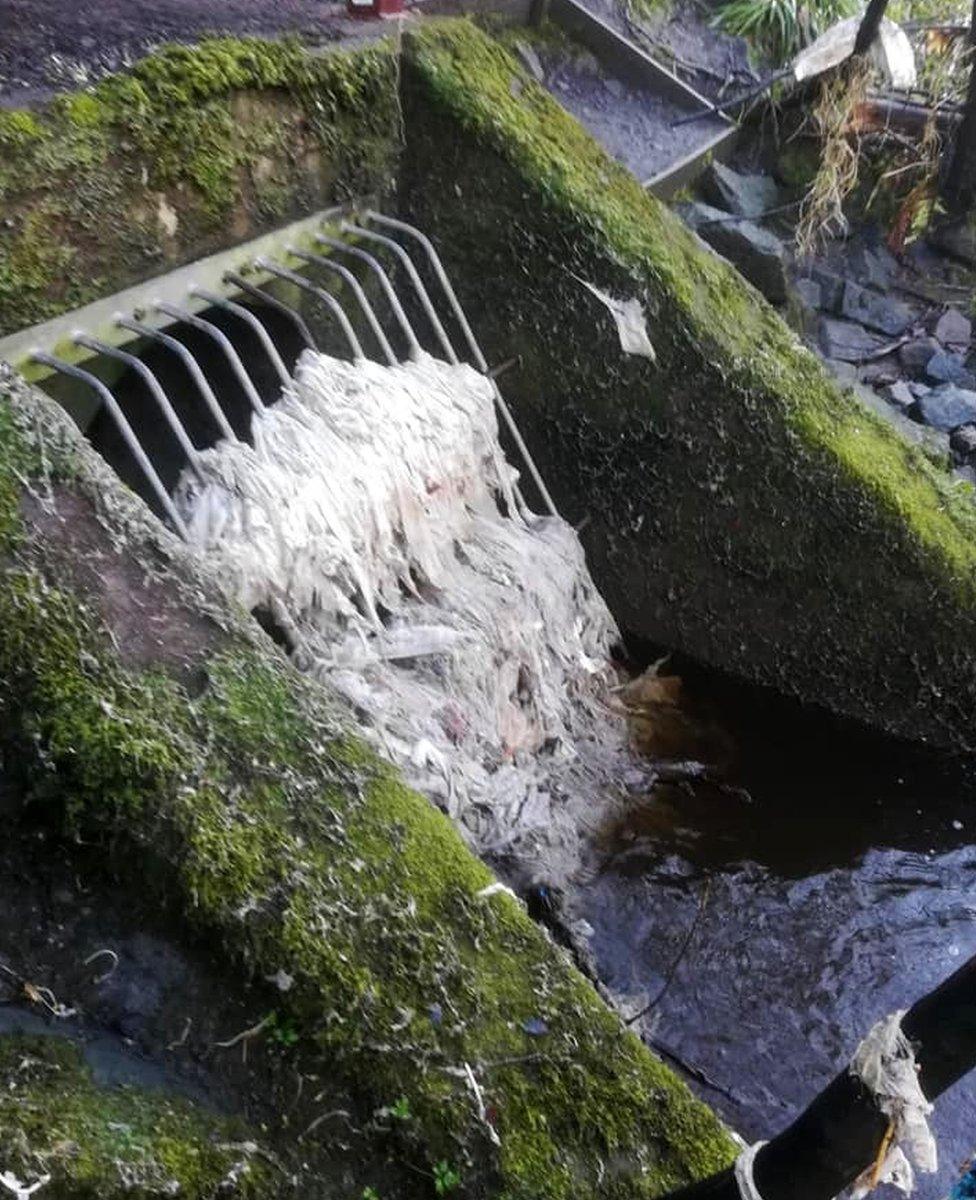
Sewage waste gathered at an overflow pipe that leads to the River Almond in West Lothian

To stop sewage backing up into homes, the storm water and waste that would ordinarily go to Scottish Water treatment centres is released into seas or rivers through the 3,697 Combined Sewer Overflows (CSOs) dotted across the country.
Many of these overflow pipes are close to popular beaches and wildlife habitats.
But Scottish Water is only required to monitor less than 3% of these CSOs for pollution, so the true scale of how much water waste is discharged is unknown.
The figures the utility firm does have show that last year there were a total of 12,725 "spill events" - up 40% on 2016.


A breakdown of these recorded overspill events in Scottish Water's network, released to BBC Scotland under freedom of information laws, has been fed into this interactive dashboard, external.
The dashboard also allows people to view a list of the number of spills, how long they lasted and how much was discharged by the part of the sewer network that is local to them.
However, the actual volume of spills is likely to be far higher.
This is because the list represents a fraction of the operating CSOs and there is no volume data provided in the FOI response for just over half of the spill events.
The data also doesn't indicate which bodies of water are being polluted by each spill.

The volume of recorded spills has also soared in the last five years, up from 12.9m cubic metres in 2016 to 48m cubic metres last year.
A total of 119m cubic metres of waste water were discharged in the recorded overflow events during this period.
Hugo Tagholm, chief executive of Surfers Against Sewage, said: "Sewer overflows seem to have been baked into the industry's thinking.
"Rather than being 'emergency release valves' during exceptional storms, they are potentially used as a means of almost continuous sewage discharge.
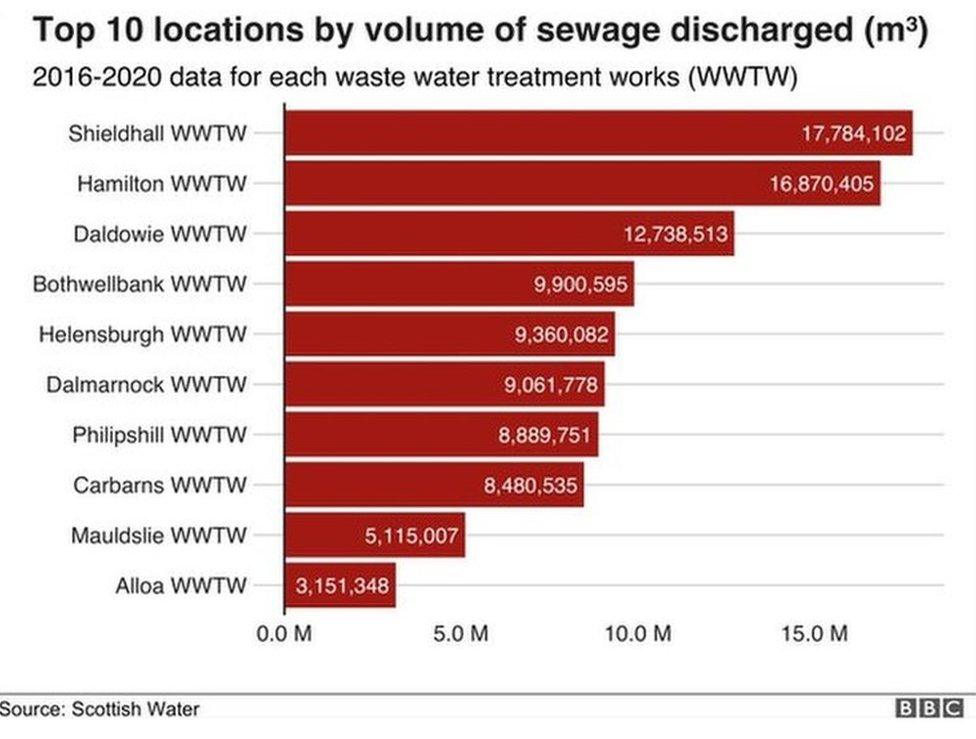
"The defunding of regulators, self-reporting of incidents, and loose and vague targets has led to the decimation of rivers and the renewed sewage struggle on our coastline.
"The time for tough new legislation and binding targets to end sewage pollution has come."
A total of 654 CSOs which do not have adequate screening to retain sewage debris are classified as unsatisfactory by Scottish Water. Some 192 of them have been in this state since before the creation of the publicly-owned firm in 2003.
The most spills at a single location were in Helensburgh, which discharges into the Firth of Clyde. There have been an average of two spills a day over the last four years.
The location with the highest recorded volume of spills was Shieldhall in Glasgow, with 17.7m cubic metres of waste water released there since 2016.
Scottish Water has estimated that to upgrade all of these unsatisfactory overflow outlets would cost at least £650m.
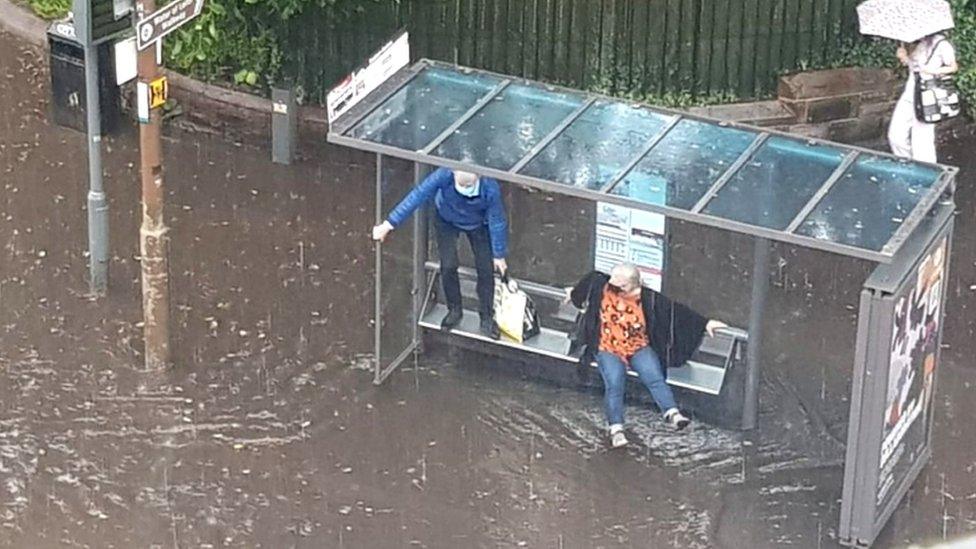
A couple stuck at a bus stop in Edinburgh during a July storm when parts of the city's sewer network were unable to cope with the rainfall
Simon Parsons, a director with Scottish Water, said CSOs "remain a vital relief mechanism to safely relieve the pressure on the sewer network".
He said the utility firm invests heavily in its 31,000 miles of waste water networks every year.
But he added: "It's not about building bigger and bigger sewers, that is not going to solve the problem."
Citing the impact of climate change on the intensity of rainfall in Scotland, he continued: "We have to stop that surface water getting into our systems.
"Last year was a wetter year than many we have had on record and it's not just the wetness over the year, it is the intensity of the storms that are coming into our sewers which is driving those spills that we are seeing."
Mr Parsons pointed out that people flushing items like wipes down toilets was still a major cause of many of the blockages that can lead to sewage spills.

'We don't know what is in the water'
“There’s raw sewage going into the river” - campaigners want action to tackle overspills
When about half of the average July rainfall fell over West Lothian in the space of a few hours, the River Almond Action Group (RAAG) knew what was coming next.
Campaigners are all too familiar with what comes out of the CSOs that discharge into the waterway after heavy rain.
"At the outlet there is raw sewage coming into the river," explains Ruth Plevin a member of RAAG.
"Everything you can imagine; plastic, tooth picks, toilet paper, wet wipes, all stuck on trees and looking like toilet tinsel.
"But we don't know what exactly is in the water because they don't tell us.
"On sunny days, the river is so appealing and people want to go in - why shouldn't they? Instead they are exposed to what is effectively an open sewer."
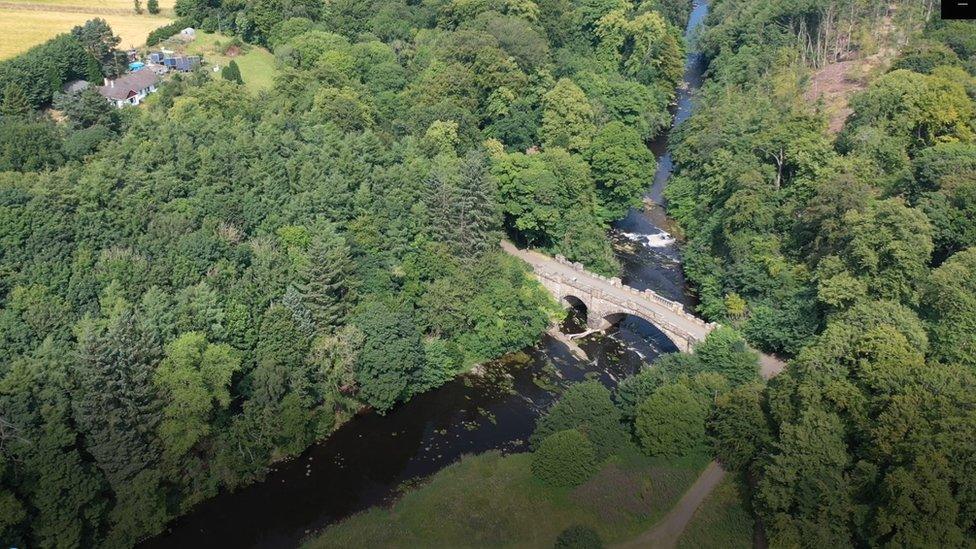
A section of the River Almond in Almondell and Calderwood Country Park which is hoped will become designated bathing waters
Veolia, which runs the East Calder wastewater treatment works under a PFI deal with Scottish Water, recently organised a clean-up that saw 65 bags of sewage debris removed from the river.
But locals are pressing for a permanent solution for a river which had an average of 1.3 sewage discharges every day in 2019.
The Forth Rivers Trust charity has applied for a section of the River Almond in Almondell and Calderwood Country Park to become designated bathing waters.
If successful it would be the first river in Scotland to join the 85 beaches with the same status, meaning stricter limits on sewage overspills and up-to-date water quality information available to the public.
Huw Streater, of the Forth Rivers Trust, said: "The Almond has suffered from serious pollution issues for a long time.
"Achieving bathing water status will help to make the Almond safer for the people who use it and the wildlife that we share it with. "

In the East Lothian village of Aberlady, resident Frank Neate has been recording evidence of what he says is waste water and sewage debris being discharged from CSOs into the village's bay during dry weather.
Aberlady bay was the UK's first nature reserve and Frank is worried about the impact of the waste on its wildlife.
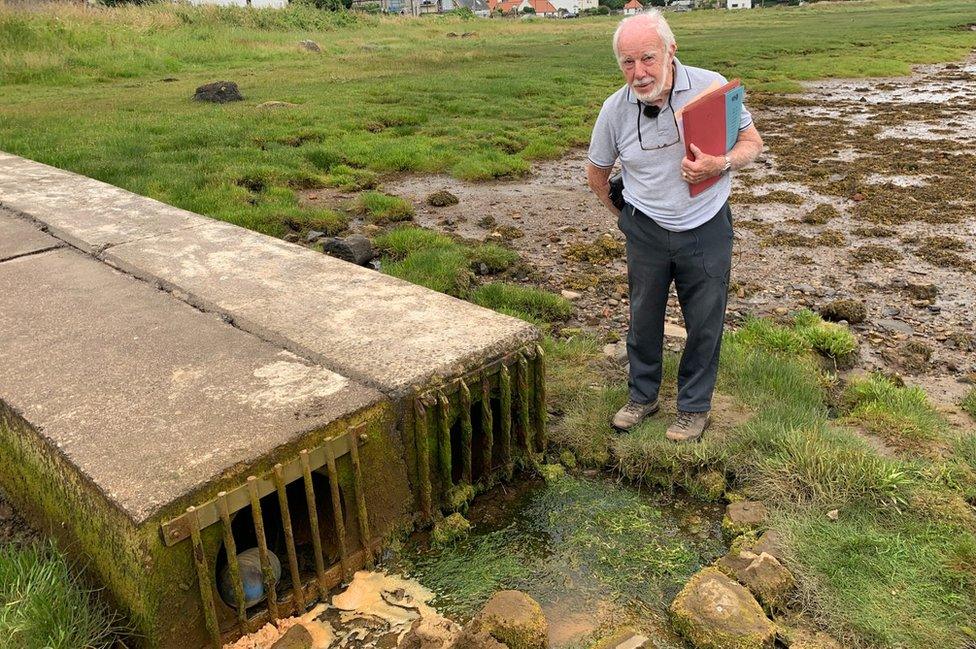
Frank Neate, who used to work in the water industry, has been keeping track of the CSOs in the bay of the East Lothian village of Aberlady
He said: "I've told both Scottish Water and Sepa this shouldn't be happening during dry weather but nobody seems interested.
"What worries me is there are kids and dogs in and out of here and people don't know what's in the water - and this in a nature reserve of all places."
The job of ensuring Scottish Water complies with the laws and standards around the sewer network and overspills falls to environment agency Sepa.
Prosecutions over sewage spills in Scotland are not common but Scottish Water was fined £19,000 last year for releasing untreated sewage into the River Clyde in Glasgow in 2016..
Sepa says it focuses its enforcement effort on prosecutions relating to more systemic issues and "significant progress" has been made in raising standards over the past 20 years "through targeted regulation and partnership work".
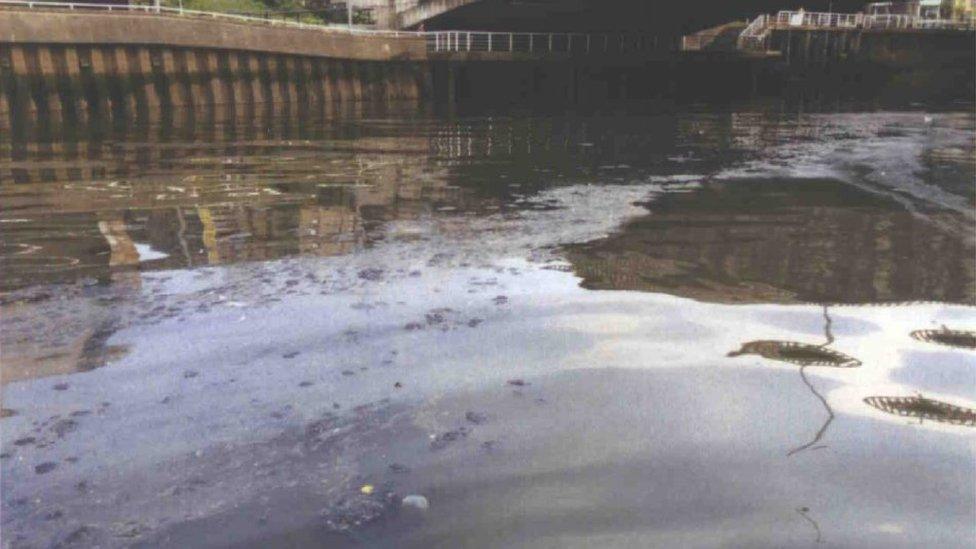
When raw sewage escaped into the River Clyde in 2016 after a pumping station failure, the smell was so bad locals were unable to open windows and had to wash soft furnishings to get rid of the odour
But Sepa figures show that in 2018 only 111 of the 345 Scottish Water sewer licences, which set the overflow conditions, were assessed for compliance.
Ten of the 111 licences inspected were found to be unsatisfactory, with the rest compliant.
The licences do not require permanent spill monitors to be installed on all of the CSOs.
A Sepa spokesman said: "We assess sewer network licenses on a rolling basis, with particular focus on those which have unsatisfactory compliance, as these can discharge sewage litter and impact on people's enjoyment of the environment."
The spokesman said an increased frequency of high-intensity rainfall meant there "is a risk that the number of unsatisfactory sewer overflows may progressively increase".
And he added that a "radical new approach to managing rainfall" was needed to reduce flood risk and minimise sewer overflow spills.
- Published29 July 2021
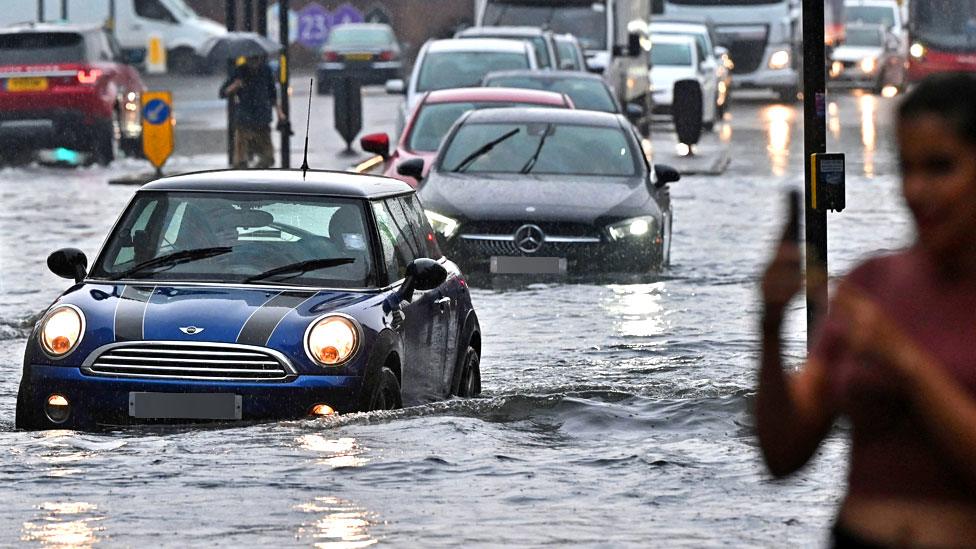
- Published25 February 2020
